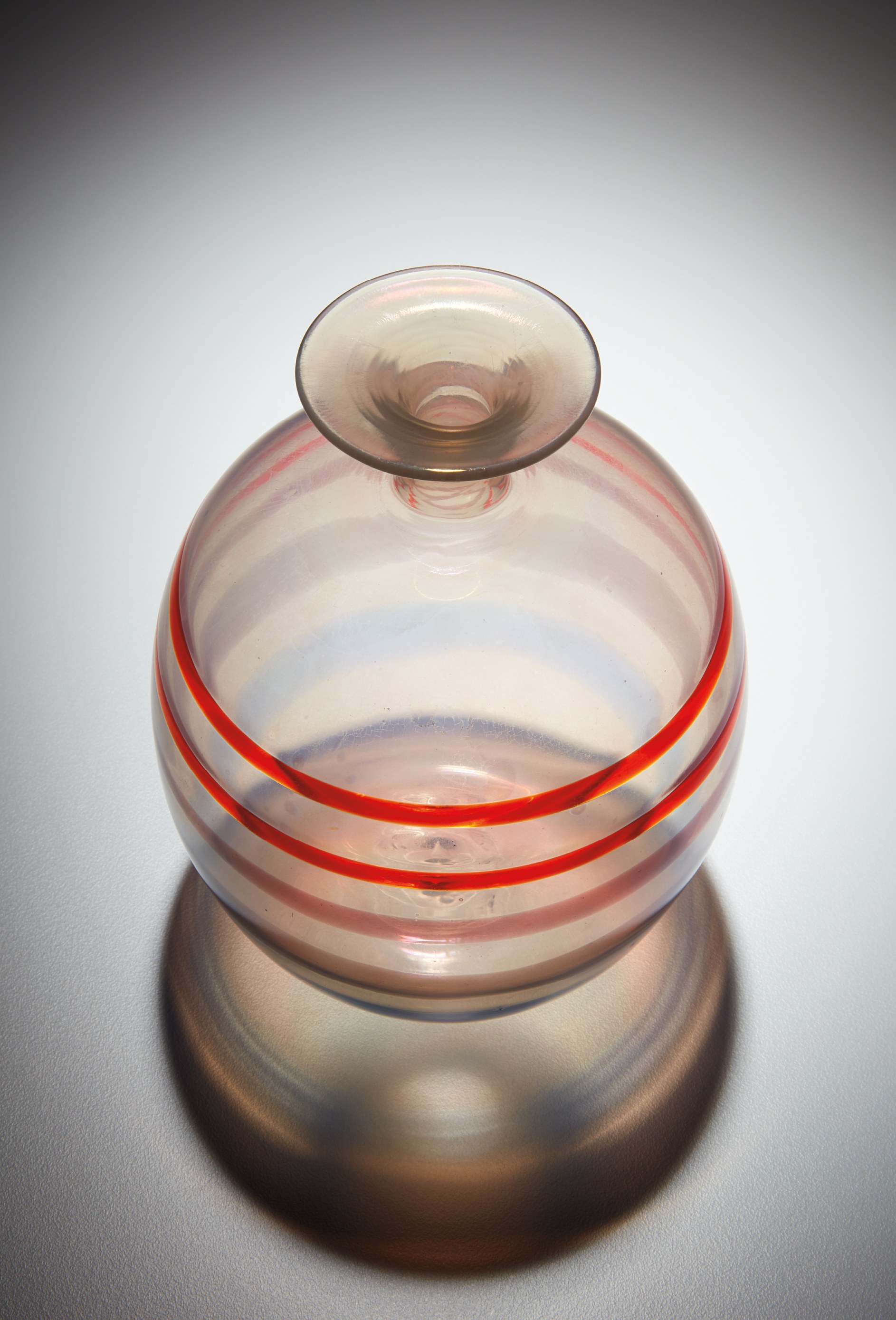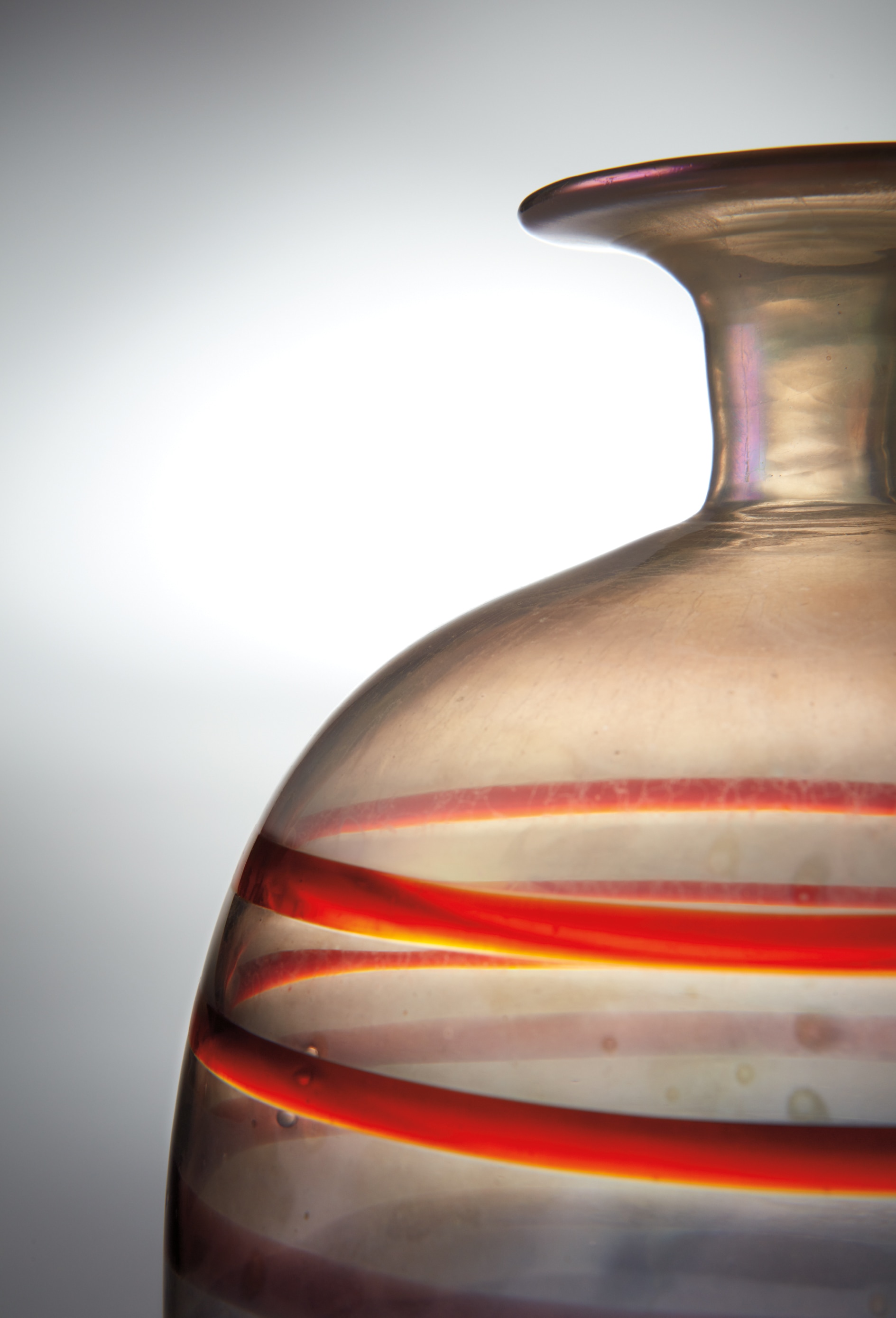







2
Carlo Scarpa
"A Fili" vase, model no. 4540
Full-Cataloguing
Clarity of Form: A Carlo Scarpa Coda for Venini
During his fertile tenure as artistic director of Venini from 1932 until 1947, Carlo Scarpa singlehandedly imbued the ancient tradition of glassblowing with a thoroughly modern spirit. Scarpa applied his boundless creativity to a prolific corpus of designs that would earn the Murano glassworks a reputation as the most forward-thinking furnace in the Venetian Lagoon. Though trained as an architect, Scarpa came to Venini already familiar with glass, having served as an artistic director at the MVM Cappellin glassworks from 1925 until its dissolution in 1931. This hands-on knowledge of the material properties of glass served Scarpa during his relentless experimentation in pursuit of innovative new manufacturing and decorating techniques.
The present lot, a blown glass vase recorded in Venini’s catalogue as model no. 4540, exemplifies Scarpa’s departure from Murano’s glassmaking tradition in its rejection of superfluous ornamentation and its embrace of essential geometric form and abstract decoration. This work is part of the a fili e a fasce (“ribbons and threads”) series of vases and bowls developed by Scarpa around 1942 and exhibited in that year’s Venice Biennale. Significantly, this series, along with the similar a pennellate (“brushstroked”) and “variegated” collections, also from 1942, are the last glass typologies Scarpa produced with Venini before dedicating himself to architecture until his death in 1978. The delicate pastel decoration of the a fili e a fasce pieces was achieved by applying a thin filament of colored glass to the exterior of the transparent form, then fusing the two together through repeated heatings during the working process. The subtle bloom, or iridescence, was obtained by exposing the worked piece to oxidized metallic compounds before cooling.
The present vase and its related works in the a fili e a fasce series display an architect’s penchant for pure form and linear decoration, and reflect the deep influence first-generation modernists such as Frank Lloyd Wright and Josef Hoffman had on Scarpa’s design sensibility. Geometry and the fundaments of line were aesthetic themes Scarpa explored in many of his earlier designs for Venini, including works decorated with intricate half-filigree (1932-36), vivid striping (1938-40), monochromatic milk glass pieces emphasizing their simple silhouettes (1936), and vessels inspired by the shapes of Chinese porcelains (1940). The ovoid form of the Scarpa vase, with its distinctively conical punt, and wide lip flange, appears to have made an impression on Tapio Wirkkala, the Finnish master of elegant glass, who later adapted its shape for his iconic Bolle series of incalmo vessels produced for Venini in 1968.
The subtle coloration and decorative restraint testifies to Scarpa’s versatility as a designer–only two years prior he had been producing radically unique series using riotously colorful murrine tessellations and vibrant tessuto patterns. Years spent exploring plasticity, opacity, and surface treatment through novel fabrication and finishing techniques yielded glass pieces which, at first glance, imitated the appearance of ceramics, lacquerwares, hammered silver, and etched stone. In their return to transparency and symmetry, Scarpa’s final designs for Venini celebrate the timeless essence of hand-blown glass, while presaging the abstracted color compositions and austere organicism that would emerge as post-war tendencies in art and design.
Carlo Scarpa
Italian | B. 1906 D. 1978Phillips Design has a deep-rooted passion for the work of Carlo Scarpa, one of the twentieth century's great poets, whose rhythms, lines and materials — a grammar of space — appeal both as a local response to the architect's birth city, Venice, and a universal language of ordered dynamism.
Carlo Scarpa graduated with a degree in architectural drawing from the Accademia di Belle Arti in Venice in 1926. In the years that followed, he worked as a teaching assistant for a former professor, ran his own architectural practice in Venice and worked as a freelance artist for M.V.M. Cappellin glassworks. When M.V.M. Cappellin went bankrupt in 1932, Scarpa joined Venini & C. in Murano, where he served as artistic director until 1947. During his tenure at Venini, Scarpa developed a host of new techniques — in particular, mezza filigrano, a bollicine and corroso — that catapulted the centuries-old tradition of Venetian glassblowing to the forefront of modernist design.